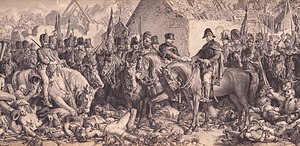On the 206th anniversary of the Battle of Waterloo, our good friend Josh Provan is back with a brief guest post highlighting five myths about the battle. Josh is a history blogger and author who runs the Adventures in Historyland blog as well as a talented artist who has created several designs on our store, including this personalised T-Shirt featuring an iconic grumpy Napoleon. Check out other products featuring Josh's designs here.

The Battle of Waterloo is one of the most famous battles in history, and many myths have developed around it. Here are some of the most pervasive ones as well as some more obscure ones:
The British Guards defeated Napoleon’s Old Guard.
The story goes that the British Foot Guards defeated the Grenadiers of the Old Guard, and celebrated this exploit by adopting their bearskins. It is true that British Foot Guards engaged and drove back units of the Imperial Guard at Waterloo during the final attack. However, they were in fact facing the Chasseurs of the Middle Guard rather than the Grenadiers of the Old Guard, who were opposed by a collection of allied infantry, including Dutch troops under General Chassé. The similarity in the uniforms of the Old and Middle Guards, both of whom wore bearskins, plus the romance of the notion of a clash of elites, and the fact that the British equated bearskins with Grenadiers, contributed to the myth that the two senior Guard units on the field duelled to decide fate of the battle.
Who won Waterloo?
One of the most eye watering myths is one that has developed in response to the equally inadequate idea that Waterloo was a ‘British victory’. Efforts to bust this myth between 1980 and 2015 created a new myth: that the British played a minor role in the battle because they only made up a third of Wellington’s army, and this army was facing defeat before the Prussians intervened. The argument about who won the battle detracts from any realistic appraisal of the action itself and is coloured by nationalist interpretations. Neither army could win the battle by themselves, but by acting according to a prearranged plan agreed by both commanders – one which Napoleon desperately sought to confound – they worked together to achieve the victory. Whatever glory hunting the respective sides did thereafter has little to do with what actually happened, or indeed how it happened.

The Meeting of Wellington and Blücher after the Battle of Waterloo
Grouchy was responsible for Napoleon’s Defeat
The oldest myth regarding the Battle of Waterloo is one that was spread by Napoleon himself, and liberally shared around by his admirers. Napoleon was not at fault for his failure to win at Waterloo, but was let down by subordinates who were either incompetent or downright treacherous. Marshal Grouchy in particular is blamed for not marching to the sound of the guns and bringing unstoppable force to the Waterloo battlefield. Grouchy can be blamed for not preventing the Prussians from reforming after Ligny, but Napoleon did not give him his orders to do so until the morning of 17 June. Grouchy certainly cannot be blamed for not ending up at Waterloo. He had only received orders to go there after Napoleon’s battle had started. Had he done so he would have arrived too late to make an impact. Blaming Grouchy’s absence for the failure of the entire campaign is without any basis.

Emmanuel de Grouchy
There was no more fighting after 18 June 1815.
After the battle on the ridge at Mont St Jean, which Wellington called Waterloo and Blücher called La Belle Alliance, the allies pursued the French to the border of Belgium. Heavy fighting occurred between the Prussians and Marshal Grouchy who fought several successful rearguard actions to get back to France with his forces intact. Once the allies had invaded France, several fortresses had to be stormed on the way to Paris, and there were some limited engagements after the got there. Marshal Davout had the opportunity to attack and potentially defeat the Prussian vanguard, but opted not to do so due to political considerations in Paris.
Fighting only occurred in Belgium.
In April 1815, before Napoleon even invaded Belgium, the Austrians had defeated Murat, the King of Naples in a campaign consisting of several battles leading up to Tolentino. This allowed them to bring their full weight to bear on France. That June, Austrian Commander-in-Chief Field Marshal Prince Schwarzenberg invaded France with a powerful Allied army, opposing them was the Army of the Rhine under General Count Rapp based in Strasbourg. Serious fighting occurred between 25 and 28 June, where among other actions, Rapp’s smaller force drove the Austrians back at La Suffel, only to be cut off by the much larger Austro-German force. In the south the Austro-Sardinian Army of the Alps under Frimont, fresh from their success against Murat, were poised to drive through the mountains to France.
On the day of the invasion of Belgium, Napoleon’s orders for Marshal Suchet to begin operations saw French troops seize the vital Alpine passes, only to lose them in turn to the Austro-Sardinians after fierce fighting at Meillerie, Conflans and Les Rousses. On 6 July Grenoble fell, followed by Lyons on the 11th and a ceasefire came into effect shortly thereafter. Had the northern allies failed in Belgium the Austrians were already in France, and the Russians were coming up behind them. Perhaps the biggest myth was the one Napoleon fed to himself when he escaped from Elba; that he could negotiate with the allies to keep his throne after he regained it.



Share and get 15% off!
Simply share this product on one of the following social networks and you will unlock 15% off!